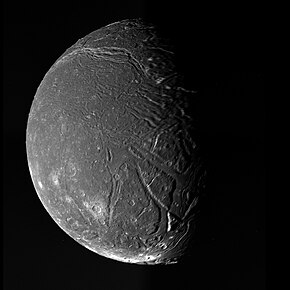 Ariel in greyscale as imaged by Voyager 2 in 1986. Extensive grabens are visible, including the Kachina Chasmata in the upper part of the image. | |||||||||
| Discovery | |||||||||
|---|---|---|---|---|---|---|---|---|---|
| Discovered by | William Lassell | ||||||||
| Discovery date | 24 October 1851 | ||||||||
| Designations | |||||||||
Designation | Uranus I | ||||||||
| Pronunciation | /ˈɛəriəl/ or /ˈæriəl/[1] | ||||||||
| Adjectives | Arielian /æriˈiːliən/[2] | ||||||||
| Orbital characteristics[3] | |||||||||
| 190900 km | |||||||||
| Eccentricity | 0.0012 | ||||||||
| 2.520 d | |||||||||
Average orbital speed | 5.51 km/s[a] | ||||||||
| Inclination | 0.260° (to Uranus's equator) | ||||||||
| Satellite of | Uranus | ||||||||
| Physical characteristics | |||||||||
| Dimensions | 1162.2 × 1155.8 × 1155.4 km[4] | ||||||||
| 578.9±0.6 km (0.0908 Earths)[4] | |||||||||
| 4211300 km2[b] | |||||||||
| Volume | 812600000 km3[c] | ||||||||
| Mass | (1.2331±0.0180)×1021 kg[6] | ||||||||
Mean density | 1.517 g/cm3 (calculated) | ||||||||
| 0.246 m/s2[d] | |||||||||
| 0.533 km/s[e] | |||||||||
| synchronous | |||||||||
| Albedo |
| ||||||||
| |||||||||
| 14.8 (R-band)[10] | |||||||||
Ariel is the fourth-largest moon of Uranus. Ariel orbits and rotates in the equatorial plane of Uranus, which is almost perpendicular to the orbit of Uranus, so the moon has an extreme seasonal cycle.
It was discovered on 24 October 1851 [11] by William Lassell and named for a character in two different pieces of literature. As of 2019, much of the detailed knowledge of Ariel derives from a single flyby of Uranus performed by the space probe Voyager 2 in 1986, which managed to image around 35% of the moon's surface. There are no active plans at present to return to study the moon in more detail, although various concepts such as a Uranus Orbiter and Probe have been proposed.
After Miranda, Ariel is the second-closest of Uranus's five major rounded satellites. Among the smallest of the Solar System's 20 known spherical moons (it ranks 14th among them in diameter), it is believed to be composed of roughly equal parts ice and rocky material. Its mass is approximately equal in magnitude to Earth's hydrosphere.
Like all of Uranus's moons, Ariel probably formed from an accretion disc that surrounded the planet shortly after its formation, and, like other large moons, it is likely differentiated, with an inner core of rock surrounded by a mantle of ice. Ariel has a complex surface consisting of extensive cratered terrain cross-cut by a system of scarps, canyons, and ridges. The surface shows signs of more recent geological activity than other Uranian moons, most likely due to tidal heating.
- ^ "Ariel". Merriam-Webster.com Dictionary. Merriam-Webster.
- ^ DeKoven (1991) Rich and strange: gender, history, modernism
- ^ Cite error: The named reference
orbitwas invoked but never defined (see the help page). - ^ a b Cite error: The named reference
Thomas 1988was invoked but never defined (see the help page). - ^ Cite error: The named reference
French et al. 2024was invoked but never defined (see the help page). - ^ Jacobson (2023), as cited in French et al. (2024)[5]
- ^ Cite error: The named reference
Karkoschka 2001, Hubblewas invoked but never defined (see the help page). - ^ Cite error: The named reference
Grundy Young et al. 2006was invoked but never defined (see the help page). - ^ Cite error: The named reference
Hanel Conrath et al. 1986was invoked but never defined (see the help page). - ^ Cite error: The named reference
Arlot Sicardy 2008was invoked but never defined (see the help page). - ^ The Times 24 October 2024 page 25 "On this day"
Cite error: There are <ref group=lower-alpha> tags or {{efn}} templates on this page, but the references will not show without a {{reflist|group=lower-alpha}} template or {{notelist}} template (see the help page).